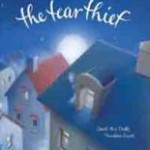
The Tear Thief by Carol Ann Duffy, Poet Laureate The first thing that caught my eye about this book is that the softness of the illustrations matches perfectly the gentle rhythm of the words. It is a lullaby, the perfect … Continue reading
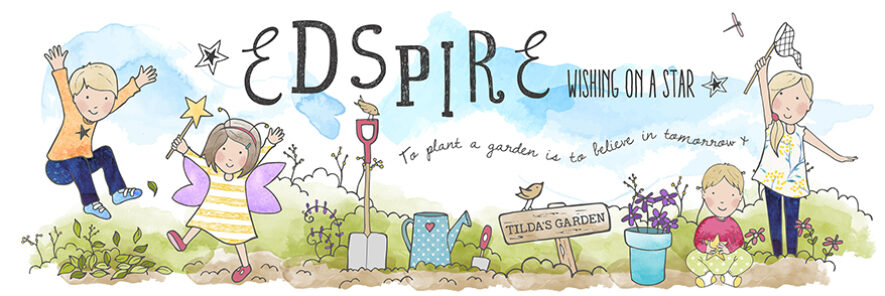

The Tear Thief by Carol Ann Duffy, Poet Laureate The first thing that caught my eye about this book is that the softness of the illustrations matches perfectly the gentle rhythm of the words. It is a lullaby, the perfect … Continue reading
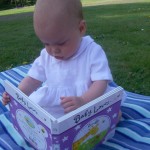
Usually when I buy books for the babies I do so online but today Esther and I went into Waterstones to choose a book to buy with her Easter giftcard from her Godmother, Laura. We looked at lots of books … Continue reading
This book by Martin Waddell I adore. It is such a simple, repetitive text but with much that can be read beween the lines. In our house this book is often performed with finger puppets! I find this text perfect for performing or reading aloud, gving each owl baby a distinct voice and character of its own. The text in parts is poetc and reads much like a lullaby. It is a classic bedtime tale.
Three owl babies, Sarah and Percy and Bill, are waiting together for their Mummy to come home from hunting. They are worried that she might not return and Bill in particular really wants his Mummy. Together they wonder where she might be and when she will be home. They huddle together for warmth and comfort until soft and silent Mummy swoops through the trees to Sarah and Percy and Bill.
This book is also perfect for use in the classroom for children aged 5 – 7.
My favourite activity is to use puppets or sequencing cards to retell the story.
You can split a class into three groups and ask each group to read the speech of one of the owls and try to imagine what that owl is thinking and feeling. The children could then extend their character profiles by using their understanding of the three personalities to try imagining how they would each respond to other situations, such as learning to fly, making a new nest and finding their own food.
During a shared re-reading of the story you can ask children to listen carefully to the babies’ speech and decide at the end of each page whether the owls are getting more nervous as the story progresses. A nerve chart/graph can be used to support visual and kinaesthetic learners. Understanding characters’ motivation for their actions is an important part of reading and understanding narrative fiction.
Ask children to think how a trio made up of their own friends and family would respond differently to various situations. Encourage children to think of times when they have been scared or excited and when they have reacted differently to a family member or friend. Think about actions, words and feelings. Role play could be used to explore different situations.
A great tool for the classroom is Role on the Wall. Draw an outline of each owl baby on the wall and then write key words about their character on to the outline. What they look like on the outside and what they think and feel on the inside of the outline. This is a good plenary activity that can be used after characters have been explored through role play.
As well as being a beautiful simple story, Owl Babies also exemplifies theuse of a full ramge of punctuation marks in context. This book is a great resource for sentence level work in literacy. How many different words, for example, can children come up with to replace ‘said’?
For a book with so few words, there is so much to be gained from sharing this story wih children in your classroom or your home.
Why not try these ideas linked to the text?
Ask children to write a set of Keep Safe rules (procedural text) for the owls when their mother is a way or for themselves in a given situation – in the playground, in the classroom etc.
Compare Owl Babies with the first chapter of The Owl Who Was Afraid of the Dark to compare the feelings of the Plop with Sarah, Percy and Bill.
Ask children to compose a speech by the mother owl to make the owls feel better. The Owl Mother puppet can be used for children to deliver their speech through. This could be a good paired activity.
Make a class reference book called ‘All About Owls’, use the information text included as an introduction to the text type and as a model for children’s own text.
Incorporate the use of ICT and create a web page, ‘All about Owls’.
A fantastic resource and a right good read!
After what can only be described as a horrible morning and early afternoon, our late afternoon was saved by reading books.
Part of my over tired, over emotional state led to me feeling a little jealous of my Mum. Stupid, I know! She is staying with us at the moment to help with the babies. Because she always gets a good night’s sleep she is so full of energy to play with Esther and William while I can barely speak out loud I am so shattered. I pathetically got to thinking that Esther and William might prefer being with her than with me! She is just so loud and so much fun!
Anyway, William was playing with my Mum when I sat down with Esther to read a book. As I started reading aloud William stopped playing and with the saddest face looked over to where we were and listened to the story too. That tiny moment, that one loving look just melted my heart. He continued to listen to the story, never not watching, from the other side of the room. When I finished reading to Esther I read to William too, the same story and one other. It was such a special time, reading with my son and daughter, that it totally made up for the rest of the day. It also made me realise that no matter what, only I will ever be their Mummy, and that counts for a LOT!!
I would like to share with you now, the books that made it all better.
Tell Me What It’s Like To Be Big by Joyce Dunbar
This is a lovely story about a little girl who wants to be bigger. When her brother tells her of all the things she might do when she is grown the little girl realises that perhaps she would rather stay small after all. A lovely tale about growing up with a subtle message of not growing up too fast. This was beautiful to read as a mother snuggled up to a son and daughter who are growing and changing every day.
Ants in Your Pants by Julia Jarman and Guy Parker-Rees
This is a fun book for reading out loud. It is written with great rhythm and rhyme. The characters are very funny and the pictures are bright and colourful. This is one that can be shared over and over again and every time you will notice something new. A great funny book full of knickers to make you giggle!
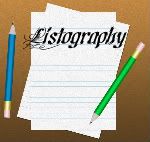 “/>
“/>
This is a fabulous listography from Kate Takes 5 this week, an opportunity to share books for babies. One of my favourite topics! As a mother and a teacher books are one of my best loves and I have been reading to Esther and William since before they were born. I read to them in the womb, beside their incubators and their cots, I read to them now on my knee and they have started to turn the pages themselves. They love to look at pictures and they enjoy watching my face as I read. I am certain that they recognise the pattern and intonation when I read certain books. Their favourites. Our favourites.
I have already blogged about some of these books and will link to them rather than write about the same books again.
The first books that we bought Esther and William are written by Oliver Jeffers and you can read about them here.
Our most read book, by far, is Eric Carle’s Brown Bear Brown Bear What Do You See? which you can read about here. This one has an audio link too!
Our best bedtime book is I Love You, Sleepyhead and that can be read about here.
We also love Hairy Maclary and share our thoughts about these fab books here.
And here are 5 other books for babies, books I have already chosen as perfect for babies of my own.
The Gruffalo
This is a magical story that rhymes and encourages children to really use their imaginations as they try to picture in their minds the monstrous Gruffalo. It lends itself to being read aloud or acted out with a range of voices. It is a great story to animate too. I love this book and so do Esther and William. We read this a lot and sometimes watch the animated version on You Tube whilst waiting for our tea.
The Rainbow Fish This is a lovely book with beautiful illustrations. It tells a story with an important message about friendship and sharing. Again it lends itself to being read aloud and provides real inspiration for arts and crafts activities. (Always the teacher!)
Click Clack Moo Cows That Type
Children’s books have to be enjoyed by the adults that read them too and I find this book hilarious. It is a comedy sketch, well written and simply illustrated. Though Esther and William are still too young to understand the humour of the book they love the differnet voices and sound effects of literate cows and ducks taking over a farm. A great, fun read.
A Cultivated Wolf
A book about the importance of books and reading. A story of friendship that appeals to all the family. Great moral too, that anyone can change their ways if they want to.
Tanka Tanka Skunk
Two animals who together sound like drums! This book is great fun to read and shout out loud over and over again. I do it with increasing vloume and speed til me and the babies collapse in fits of giggles. It is great fun! Great in the classroom for teaching about rhythm and breaking words up into syllables. A book that encourages you to really play with words and have fun.
And books for another time … The Silver Sword, I Am David, The Machine Gunners, When Hitler Stole Pink Rabbit, Children on the Oregon Trail, The Secret Garden, Private Peaceful … I could go on and on.
I hope that we have another book listography soon, in the meantime, come and join in this one. I have read everyone’s posts with my Amazon account open and we will have a lovely large box of books on the way come Friday. Thank you everyone!
The Silver Sword is a book that has stayed with me all of my life, or at least since I first discovered it in primary school when it was read to me by my teacher, Mrs Foster.
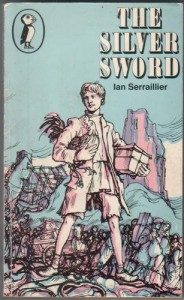
The Silver Sword is a story based upon true fact that touches my heart every time I read it.
It is an inspirational story of tremendous courage, hope and determination in a terrible situation. It is the tale of four children’s struggle to stay alive as they journey through war-torn Europe, during the years of Nazi occupation.
This is a book that I will definitely hare with my own children and one that I have used in my teaching with children from Years 5 and 6. As well as being a story to share for its own sake it can also be a powerful text to use as part of a literacy or history lesson.
Personally I would incorporate the novel into a half term topic about war and conflict focusing on children and refugees. I believe that this would enhance the children’s understanding of the setting of the story, time and place, and help them to empathise with the characters and their situation. It would also give opportunity for looking at war poetry and other related texts such as When Hitler Stole Pink Rabbit and I Am David, two of my other most favourite books!!
I believe that The Silver Sword is a strong story, appealing to both boys and girls. I also feel that it is a novel that children can become really involved with and feel passionate about as the main characters are the same age as them and share similar likes and dislikes. They can really try to put themselves in their shoes.
At different points in the story children can further their understanding of and empathy for the characters by using hot-seating. One person would assume the role of a character from the novel and the other children would ask them questions about how they are feeling at a certain time, what are their fears, their worries, their thoughts about the other children and characters in the book. This would be a good way of considering what happened to Edek before the other s find him and or to Jan before he finds the others, or to the mother. It helps to enhance the understanding and enjoyment of the story by encouraging children to really read between the lines and think what could have happened based on what they already know about the novel and the war situation. It also helps to ask children o try to relate what they are reading to their own lives in some way, perhaps through emotions and feelings. When have you felt sad and lonely? Who is your best friend and why? If you had a treasure box like Jan’s what three objects would you put into it and why?
This book lends itself to being a platform for discussions about refugees and children’s experiences of war. It would be interesting to work with different charities such as The Red Cross to really develop understanding and compassion in this area.
On a creative note it would be good practice to watch the television serialisation of The Silver Sword, with children at home or at school, and notice and discuss any points that are different from the book. This would include evaluating the performances of the actors playing the main characters. Is it well cast? Do the characters loo as you imagined them to? Who would you cast in each role?
With my own children at home and pupils at school I would ask them, at the end of each reading session, to make a prediction of what they think might happen next in the story. Anticipating what might happen next in a text is an important part of reading, it is how we link what we know, what we think and what we have read together. It helps us to make sense of what we are reading and it uses imagination and creative thought.
I believe that as well as being great to read The Silver Sword provides a springboard form which many forms of writing can be launched (or sprung! ) – diaries, letters, stories, poems, reports, recounts, information texts, arguments and many more. The book has strong characters and a good plot with some chapters that could potentially lead to very powerful, creative interpretation, particularly Chapter 27, The Storm.
This book gets me so excited!
English is a subject that I have always been passionate about and I hope that through this passion, my knowledge of children’s literature and my ability to meet educational objectives through that literature, I will be able to inspire my own children and the pupils that I teach in my classroom to love English and books just as I do.
The story of The Silver Sword takes children on the journey of The Balicki Family but it is also a very personal journey where it is possible to discover many new ideas, new words, new thoughts and new inspirations. I truly believe that children take something from every story they read that moves them a little further on in their journey of discovering exactly who they are and what they want to be.
On this World Book Day 2011 I recommend this book as a winner with children aged 9 – 99.
Every journey begins with a single step so perhaps reading The Silver Sword could be yours.